
Food Healthiness at Sea Menu: 1 2 3 4 Next>>
Food Healthiness at Sea During the Golden Age of Piracy, Page 3
Healthiness of the Sailor's Diet: The Food
"George Kendall, writing from Deptford Yard [in 1653 said] ...in his view the victuals were one of the main causes both for the sickness and for the unpopularity of the service: the seamen, he said, resented that they were compelled ‘to feed upon unwholesome and stinking victuals, whereby many of them are become sick and unserviceable and many are dead’. Such reports all suggest that the epidemic, like that in March and April, was dysenteric." (John J. Keevil, Medicine and the Navy 1200-1900: Volume II – 1640-1714, 1958, p. 48)
It is next to impossible to find a discussion of food during the golden age of sail without some sort of indictment of it. Most of this centers around naval victuals, at least in part because the navy had official channels for registering complaints which were saved
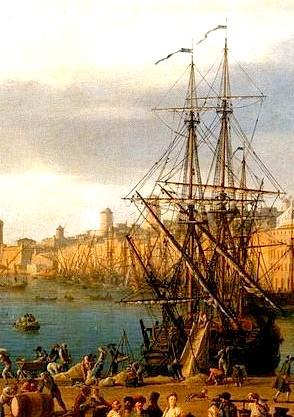
Artist: Claude-Joseph Vernet
Loading a Ship, From Interieur du port de Marseille (1754)
in the English archives. Writing about the navy during the reign of Queen Anne (1702-14) Commander R.D. Merriman points out that much of the lack of quality and quantity of food at sea likely had to do with the inability to effectively preserve the food at sea. "The salting of beef and pork was done very crudely; a high proportion had to be condemned after being on board but a few months. The dietary scale was almost entirely lacking in anti-scorbutics [foods which prevented scurvy], and the beer on which the men depended, because water went foul after a few weeks in casks, itself became sour."1
Other factors also impacted the quality of the food served to the sailors. In a letter from the Lord High Admiral to the Navy Board in December of 1708, the board was told that "it may be necessary to hire porters to carry the casks of flesh and oil from the waterside into the storehouses ... instead of rolling them on the stones (which damnifies [damages] the cask and occasions the pickle [brine] to run out, whereby the meat decays), you are to give directions to the Commissioners ... to take particular care the same be done"2.
Coming from yet another angle, historian Emily Cockayne points out that cooking pots whose inside tinning was damaged, the metal which the pot was made from would "leech into the food giving it a brassy taint."3 In support of this, Edward Ham, probably the cook or one of his mates aboard the merchant ship Adventure in 1698, was punished "upon a complaint of the copperishness of the Pease [peas], the Captain himself went into the Cook-room, and took off the sides of the Copper [pot] a great quantity of Verdigreese, for which the Captain beat him with a Japan Cane [probably bamboo]"4. Verdigris is a blue-green patina on copper and brass which is caused by oxidation. In this case, Ham may have been punished for not keeping the pot clean rather than not having it re-tinned.
There were a variety of complaints about the goodness (and thus the healthiness) of different types of food during this period, most of it from naval records. Since the food eaten on naval voyages was likely the same as was eaten on merchant, exploratory and privateering voyages (at least in the beginning of such trips) and since pirates got much of their sea fare from merchant ships, the complaints are worth reviewing here. In addition to the many complaints, there are a few comments which are more complimentary to navy fare. As mentioned in the section on salt, it must be remembered that people are far more likely to complain about problems like this than to praise it when they get what they expect.
1 Commander R. D. Merriman, Queen Anne's Navy, 1961, p. 250; 2 Merriman, p. 288; 3 Emily Cockayne, Hubbub: Filth, Noise, and Stench in England, 1600-1770, 2007, p. 102; 4 "49. Mutiny on the Ship Adventure”, Pirates in Their Own Words, Ed Fox, Ed., 2014, p. 256
Healthiness of the Sailor's Diet: Dried Foods (Peas and Oatmeal)
The dried foods received the fewest number of complaints. In fact, the only such comments come from Sir Robert Robertson of HMS Assistance in 1681. Of these, he griped, "The peas boiled almost as hard as shot, and would by no means break. The oatmeal was so sour that many times it could not be eaten."1 This took place during peace time, almost ten years before the beginning of the golden age of piracy.
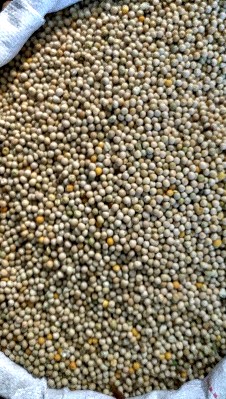
Photo: Salim Khandoker - Dried Peas
Historian J.D. Davies explains, "From 1660 onwards the most frequent complaints about poor victuals came in peacetime, when the victuallers might be tempted to offload commodities that had been in store for some time, and from ships on foreign stations, which had less opportunity than ships in home waters to check and replace inferior victuals before it was too late."2 The Assistance was then serving in the Mediterranean.
Navy physician William Cockburn had a very positive view of both peas and oatmeal. Of the oatmeal, he explained that it was
very fit to correct that thickness of the humours and costiveness [constipation], that are the unavoidable consequences of the [sailor's] diet join'd with the least idleness: for Oats being of a thin substance, and of all the grains we use for victuals, that out of which the greatest quantity of oyl may be drawn, they not only preserve that motion, that's requisite to make a due perspiration [to cleanse the bad humors from the body], by adding spirits to the blood, but preserve it in a convenient degree of fluxility [capable of being fused]; and by their cleansing power and vertue to keep the belly open [to prevent constipation], this Burgoo victualling is highly necessary for our seafaring people.3
Cockburn goes on to note that ", 'tis the least lik'd of all their victuals because of the small quantity of Butter, they pretend is allowed them to sawce [sauce] it"4. He suggested allowing the sailors more butter, because if oatmeal "were made more grateful and agreeable to the Sailers, 'twould infinitely contribute to the preservation of their health."5 In that, he may have had a point. He also stated that peas had much in common with oatmeal and "in their own nature are more temperate than Oatmeal, since they are esteem'd by Physicians, and the learned Galen"6.
1,2 J.D. Davies, Pepys’s Navy, 2008, p. 202; 3 William Cockburn, An account of the nature, causes, symptoms, and cure of the distempers that are incident to seafaring people, 1696, p. 24-5; 4,5,6 Cockburn, p. 25
Healthiness of the Sailor's Diet: Biscuit (Ship's Bread)
The first thing that comes to many people's minds when the badness of biscuit is mentioned is that it was infested with weevils, thanks largely to the way it has been presented in movies. In his book on scurvy, Steven Bown gives a rather lurid account of the insects and their presence in the sailor's bread:
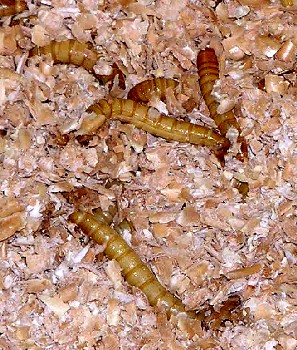
Photo: Wikimedia - Meal Worms in Bran
weevils crawled; they were bitter to the taste, and a sure indication that the biscuit had lost its nutritious particles; if instead of these weevils, large white maggots with black heads made their appearance (these were called bargemen in the Navy), then the biscuit was considered to be only in its first state of decay; these maggots were fat and cold to the taste, but not bitter. Sailors were known to be particularly suspicious of hardtack that contained no weevils or maggots, believing it to be too bad even for these ever-prevalent pests.1
Unfortunately, Bown doesn't provide any sources for these comments, so it is difficult to determine how accurate his information is and to which period in history it applies. In fact, none of the comments from the golden age of piracy about bread specifically mention weevils. This is not to say that there weren't any at that time; there almost certainly were. It may be that the GAoP age sailors really did expect biscuit to have weevils, but there is nothing to directly back this up. However, there is evidence of insects in the bread and flour on naval vessels. English navy clerk John Baltharpe wrote a poem about the journey of the St. David, noting that in 1670, "Our Bread is black, and Maggets in it crawl"2. A comment from around 1704 by privateer William Funnell, an officer aboard the St. George, notes that their crew "had nothing to trust to, but our half pound of Flower [flour] a Day for each Man, and that very full of Vermine, Maggots and Spiders."3
Weevils found in flour and bread are a type of beetles whose larval state is the mealworm. They consume grain and would likely be found whereever grains were stored. If they were baked into biscuit, the heating process would kill them making them harmless. The two citations may actually be referring to weevils; in their larval state, they do look somewhat like maggots.
Still, most of the complaints about the biscuit deal with its texture
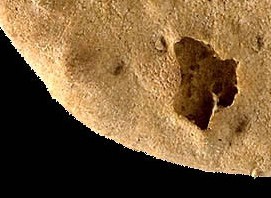
Ship's Biscuit (1784)
and state of decay. German surgeon Johann Dietz, serving on a Dutch whaling ship in the late 17th century said, "on deck, in open crates was plenty of biscuit; which had to be broken and softened in water, otherwise no one could eat it, so hard and mouldy was it."4 In the early part of the eighteenth century, sea surgeon Patrick Campbell said, "[T]he bread brought the skin off men’s mouths and so spoiled the gums and loosened their teeth that they could not chew their victuals."5 In 1708, the Lord High Admiral of the English Navy reported that "at Gibraltar, there has been a great quantity of bread lain in store there which, though decayed, was issued to the fleet to prevent the entire loss thereof; which gave no little dissatisfaction to the seamen, who found themselves obliged to eat what the soldiers refused."6 Of course, the cause of decay in the last citation isn't described and it may well have been weevils or other insects. However, other citations mention how tough the bread was, which doesn't suggest something eaten through by insects.
Photo: Sten Porse - Danish Rye Bread or Rugbrød
One other complaint, quite different from the others comes from inveterate whiner Edward Barlow. He explained that while serving aboard the Royal Charles in 1659, they were stationed off Copenhagen, they were running low on English provisions and were forced to eat "some of their [the Danes'] country bread, which was black as bean bread"7. (Barlow was likely talking about Danish rye bread - rugbrød. This may have been twice-baked, although that is not clear from his comment.) Barlow's comment speaks directly to the idea that the sailors preferred what they were used to eating over substitute victuals.
Naval physician William Cockburn had much to say on the healthiness of bread, noting, "Moderate eating of bread has, in all ages, been esteemed to contribute very much to the preservation of our health"8. He felt it helped slow the movement of food through the digestive system, without which the chyle created during digested lacked the 'necessary body' to move properly through the body resulting in "gripings [sharp pain in the bowels], most troublesome loosenesses [diarrhea], and such other sicknesses."9 However, he also warned that too much bread was bad because it was "not so easily broken and divided by the stomach, and if eaten at any time in a greater quantity than is sufficient to give a body to the Chyle, it is very apt to make way for obstructions, and to breed very thick and gross humours."10
1 Stephen Bown, Scurvy, 2004, p. 20; 2 John Baltharpe , The Straights Voyage, or, St. Davids Poem, 1671, p. 58; 3 William Funnell, A Voyage Round the World, 1969, p. 226; 4 Johann Dietz, Master Johann Dietz, Surgeon in the Army of the Great Elector and Barber to the Royal Court, 1923, p. 128; 5 Patrick Campbell, cited in Zachary B. Friedenberg, Medicine Under Sail, p. 30; 6 "37. Lord High Admiral to Navy Board, 27 December, 1708", 5 Cited in Commander R. D. Merriman, Queen Anne's Navy, 1961, p. 287; 7 Edward Barlow, Barlow’s Journal of his Life at Sea in King’s Ships, East and West Indiamen & Other Merchantman From 1659 to 1703, p. 35; 8 William Cockburn, An account of the nature, causes, symptoms, and cure of the distempers that are incident to seafaring people, 1696, p. 21-2; 9,10 Cockburn, p. 22
Healthiness of the Sailor's Diet: Dairy (Cheese and Butter)
Two dairy products were staples of the navy diet: cheese and butter. Not surprisingly, a variety of complaints appear in the naval records about them. Historian Emily Cockayne
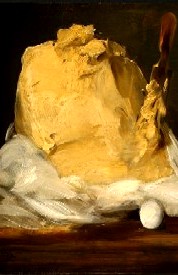
Artist: Antoine Vollon
Butter and Egg (late 19th c,)
explains, "Cheese was especially prone to adulteration, but hair and other stray impurities from the diary could infiltrate at the processing stage. Slovenly dairying was hard to conceal, and casual workings were evident in the product."1 Of butter, she explained "Cheap butter was poor grade, akin to grease and was often imported from Ireland."2 Whether either or both of these comments apply to navy stores can't be ascertained. Dairy products did receive their share of complaints, though.
In February of 1668, Captain Thomas Allin on HMS Monmouth received from the victuallers "butter and cheese was so bad that we returned all the cheese being rotten and 8 or 9 firkins of butter, it stank so."3 In July, 1702, when the fleet was anchored off Plymouth "there were ‘great complaints coming from all commanders of the fleet of the badness of the butter and cheese’"4. Captain Cavendish of HMS Tyger sent a letter dated September 4, 1703 "complaining of the badness of his beer, butter, and cheese."5 The Navy Victualling Board replied that the butter and cheese "was furnished at the latter end of the cheesemonger's contract, before new could be procured, though he had the best that could then be got. But the same will be the cheesemonger's loss."6 This meant that the supplier of the cheese would not be paid because he supplied the bad butter and cheese. The navy was having trouble paying their victuallers in the beginning of the 18th century, so the Cheesemonger may not have been paid for months or more anyhow. Whether he got paid or not would have been small comfort to the men of the Tyger.
The next year, a letter was received from Rear Admiral John Jennings "complaining of the butter sent from Portsmouth in vessels for the use of the squadron under his command"7.

Artist: Geoffrey Kneller
Rear Admiral John Jennings (1708-09)
The Victualling Board discussed this with the cheesemonger, who "assures us that the said butter was good when shipped, which was May [1705], though of the former year's making, no other being then to be had. But it may well be presumed the length of the passage might occasion the defect thereof"8. Jennings' fleet of navy and merchant ships had sailed to the Mediterranean in March, returning to England in September. it would not be entirely surprising that dairy products made in late December of the previous year might be spoiled by September of the following year. However, it is not clear at what point the butter was determined to be spoiled.
With regard to the healthiness of cheese, Cockayne cites near-period sources which state, "Good cheese came with a ‘rough moist coat’, but not too moist, as this was ‘apt to breed Maggots’. ...[Hannah] Glasse recommended that the buyer judge how far rot and holes penetrated the whole block, warning that worse horrors may lurk within."9 None of the cited examples provide enough detail about the defects of the cheese to determine what was wrong with it, however.
From a medical perspective, Thomas Tryon said, "Cheese is a wholsom healthy Food, a great strengthener of the Stomach, affording a strong firm Nourishment and such People as eat much Bread and Cheese, and do not want good Beer or Ale, are generally the strongest of men, abler to endure Labour and Travel, than those that feed on Flesh"10. Tryon ties the healthiness of butter to the individual temperaments, suggesting that those of a phlegmatic constitution eat it 'sparingly'11 while those with a sanguine constitution will find butter and cheese part of "a strong healthy Diet."12 He also points out that "[olive] Oyl is an excellent thing in Nature more sublime and pure than Butter"13. Still, in general terms, Tryon supports dairy and dairy products along with bread and grain-based dishes as 'wonderfully' supporting nature.14 Other than suggesting more butter be allowed to encourage the men to eat oatmeal as previously mentioned, navy physician William Cockburn doesn't say much about the healthiness of either butter or cheese.
1,2 Emily Cockayne, Hubbub: Filth, Noise, and Stench in England, 1600-1770, 2007, p. 100; 3 John J. Keevil, Medicine and the Navy 1200-1900: Volume II – 1640-1714, 1958, p. 114; 4 Keevil, p. 209-10; 5,6 "7. Victualling Board to Secretary of the Admiralty, 11th September 1703", Cited in Commander R. D. Merriman, Queen Anne's Navy, 1961, p. 261; 7,8 "20. Victualling Board to Secretary of the Admiralty, 6th October 1705", Cited in Merriman, p. 276; 9 Cockayne, p. 100-1;10 Thomas Tryon, The Way to Health, Long Life and Happiness, 1697, p. 56;11 Tryon, p. 18; 12 Tryon, p. 22; 13 Tryon, p. 46; 14 Tryon, p. 57

